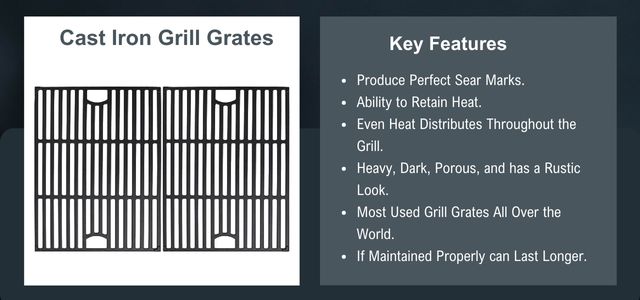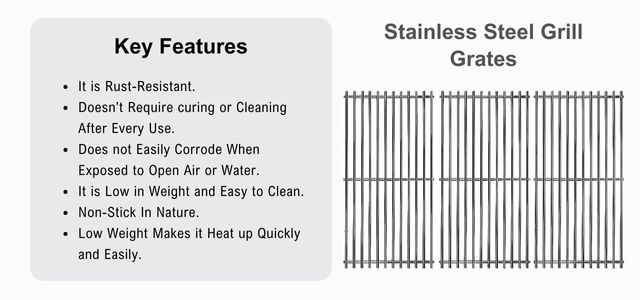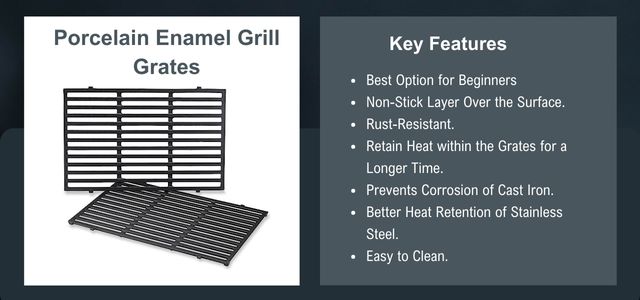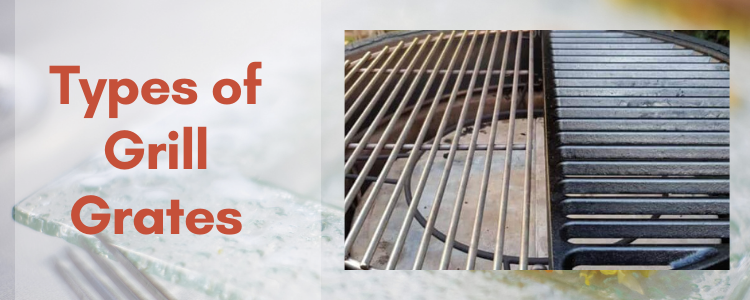Almost every home in the United States has at least a grill, either an indoor or an outdoor one. There are many other options available in the market, like smokers, griddles, or flat-top grills, but we will discuss the types of grill grates in the article.
There are three main types of grills available in the market. The most common and used one is cast iron grill grates, the other being Stainless steel grill grates and the last one that the newbies mainly use are Porcelain enameled grill grates that are easy to use.
Grilling is not an easy task. It requires time, money, and experience. Experience being at the top when you have time, as time is the most precious thing in the world. Spending time with loved ones is the ultimate goal in life. Apart from choosing a suitable time, you have the best accessories to make your loved ones happy with your grilling experience.
What are Grill Grates?
The most important thing in order to start grilling is the grill grates. If you know how to grill, then you have the idea that grill grates are the basic necessity to elevate the grilling power and meet the desired taste you are experienced in.
A grill grate is a metal grate that is used to support a grill over a grill fire. Grill grates are important because they allow for the heat to travel directly into the food being cooked on the grill. If you do not have a grill grate, then you may need to buy one to make your grilling easier and safer.
What is Grill Used for?
A grill is a cooking device having parallel bars. These bars are called grill grates on which food is exposed to heat (either from charcoal, pellets, or electricity). These grates are made from a variety of materials like Cast iron, Porcelain, or Stainless steel.
The grill grates are responsible for equal heat distribution over the grill’s surface and reduce the flare-up condition that burns the stake. This even distribution of heat is necessary for the fast grilling process and ensures the iconic sear marks over the grilled food, increasing the presentation aesthetic.
Advantages of using Grill Grates?
The food cooked over the grill has more flavor as the food is directly in touch with the heat through these parallel bars called grill grates. When the food gets heated up, the juice starts dripping from the food over the grill and gets vaporizes around the food, which prevents the food from drying up and locks up the remaining juice within the food, which makes it juicer than the food cooked over the griddle or in a grill pan.
Types of Grill Grates
There are three basic types of Grill Grates:
- Cast Iron Grill Grates.
- Stainless steel Grill Grates.
- Porcelain Enamel Grill Grates.
Cast Iron Grill Grates

Cast iron is an alloy having elements in different quantities. The main element is iron, carbon is the second most element having 2 to 4 percent in total with a varying amount of silicon, and manganese. It has traces of impurities in the form of sulfur and phosphorus. It is heavy, dark, porous, and has a rustic look. The heaviness is due to iron. The dark color comes from carbon which is the second most in percentage.
It is one of the most used grill grates all over the world. It provides the best grilling experience because of its heat retention feature that grills the food in its best form, but it comes with some issues that are hard to overcome if you are a newbie. It gets rusted when exposed to open air or when not cleaned properly after using it. Restoring cast iron grill grates is tricky and can end with their destruction if you don’t know how to clean them properly.

Features of Cast Iron Grill Grates
- The best quality of cast iron is its heat retention.
- One of the best advantages of using cast iron as it delivers even heat throughout the grill.
- The juiciness of the food is due to the even heat distribution of the grill grates.
- The even and high heat makes the food dip the juice from the outside, making the remaining juice lock within the food, giving a unique flavor to the grilled food.
Perfect Sear Marks
Cast iron grill grates get heated high, making the sear marks perfectly all over the food, improving the appearance of the food.
Disadvantages of Cast Iron Grill Grates
1. Taking full care of the Grill Grates
One of the main concerns of cast iron grill grates is it get rusted as it is porous and get rusted easily when not cared for properly. When done with grilling, scrape them immediately. When done with scrapping, oil them completely. The oil will fill the open pores and will eliminate the chances of getting it rusted.
2. Weight of Cast Iron Grill Grates
The other one is the heaviness of the grates. This feature makes it difficult to access the fire to the person grilling on it. It takes a longer time to heat up because of the thickness, but when it gets heated up, it is not easily cooled down and makes it easy to grill for a longer time.
Pros of Cast Iron Grill Grates:
- Produce perfect sear marks.
- Even distribution of the heat.
- High heat retention of the grill grates.
- If maintained properly can last longer.
Cons of Cast Iron Grill Grates:
- Heavy in weight.
- Easily gets corroded.
- Requires proper maintenance.
Stainless Steel Grill Grates

Stainless steel is a type of steel in which different metals are added that have specific characteristics. It contains 10.5 percent chromium which has the feature of non-sticking. It contains 1.2 percent carbon and other alloy elements in smaller amounts.
Most grill grates these days are constructed of stainless steel, implying that they are rust-resistant. While this is correct, the stainless steel surface remains clean. Other elements on the surface will rust. Sauces/marinades, meat remains, and steel wool from cleaning are all common reasons. When iron particles in steel are exposed to oxygen and moisture, reddish-brown corrosion rust occurs.

Features of Stainless Steel Grill Grates
- The main feature of stainless steel grill grates is it doesn’t require curing after every use, which is a daunting process.
- It does not easily corrode when exposed to open air or water, but it may get darkened and lose its luster over time if not well maintained.
- It is easy to use because of its low weight and easy to clean as the grates have chromium, making it smooth from the outer side.
- One of the most outstanding features of chromium is its non-sticking characteristic.
- Pure stainless steel is highly corrosion-resistant, but it is not entirely corrosion-free.
Maintenance of Stainless Steel Grill Grates
It requires low maintenance as compared to cast iron. The low weight makes it heat up quickly and easy for the people working with it to move, which helps access the coals underneath. When grilling is done for a longer time, the heat and regular cleaning degrade the surface. The silvery appearance vanishes as several microscopic pores appear on the surface, which makes it prone to corrosion.
Disadvantages of Stainless Steel Grill Grates
One of the disadvantages of stainless-steel grill grates is their low heat retention. Because of their thinner body, the heat does not retain for an extended period. The same thinner body does not disperse the heat equally all over the grill, which makes false sear marks and leaves the food with hot and colder spots all over the grilling food.
Pros of Stainless Steel Grill Grates:
- Low in price.
- Quickly heats up.
- Corrosion resistant.
- Light and easy to move.
Cons of Stainless Steel Grill Grates:
- Low heat retention.
- Smooth surface degrades over time.
- After time food gets stuck with grates.
Porcelain Enamel Grill Grates

Enamel-coated grill grates are the best option for beginners as well as for masters. It creates a non-stick layer over the surface and venerates the metal underneath, which resolves most of the issues of cast iron and stainless-steel grill grates.
There are two types of porcelain grill grates. The first one is Porcelain-coated iron grill grates and the other one is Porcelain-coated stainless steel grill grates. Both types are heat and rust-resistant, but they must be cleaned and maintained. Any chips or scrapes in the porcelain will reveal the metal beneath, allowing water to seep in and cause rust. So be careful not to scrape or nick the grates with metal objects when cooking.

Types of Porcelain Enamel Grill Grates
- Porcelain Enamel coated Stainless-steel Grill Grates
- Porcelain Enamel coated Cast iron Grill Grates
Features of Porcelain Enamel Grill Grates
It prevents the metal surface from corroding, retains heat, and does not require seasoning and curing regularly. One of the good points with enamel coating grill grates is it’s durable as the main material is heavy cast iron or stainless steel, the enamel coating just venerates the main material and makes it easy to clean.
1. Enamel-coated Stainless Steel Grill Grates
Stainless steel has a big issue with heat retention, as it is thinner and can’t store or retain heat for a longer period of time and does not disperse the heat equally and properly, which leaves the food with false sear marks and improperly cooked food. The enamel coating considers these issues. Due to the proper enamel, the heat remains within the grates for a long time, making the food cooked properly and leaving the food with ironic grill marks.
2. Enamel Coated Cast Iron Grill Grates
The main issue with cast iron grill grates is their easily corroding feature. But it has many advantages as it retains the heat, disperses it well all over the grill, and makes the food capture its juice without losing it. The other one is the mark it leaves on the food, which makes the presentation professional. The enamel coating removes the corrosion issue even if it leaves unclean after use. Due to the coating, the cleanness is very easy, and it takes just a few minutes to clean it properly.
Pros of Porcelain Enamel Grates:
- Prevents corrosion of cast iron.
- Better heat retention of stainless steel.
- Non-stick coating over main material.
Cons of Porcelain Enamel Grates:
- Heavy to handle.
- Expensive to buy.
- Loses non-stick property over time.
Do Stainless Steel Grill Grates Rust?
Stainless steel is a type of steel that is prone to rust. But it gets rust if it is not well maintained for a longer period. However, it can be dealt with if it’s surface rust. It will be removed properly and requires proper accessories, including baking soda, water, aluminum foil, and a rag. The rust can be removed completely, but the grates will never be the same as the new ones as the shiny surface vanishes after cleaning the rust with chemicals and aluminum foil.
What Grill Grates Last The Longest?
Among all the grates, stainless steel grill grates are the most popular because of their durability and ease of cleaning. You don’t need to spend time cleaning these grates. You can use them with ease without getting rid of the seasoning. This is why they last the longest. You won’t find the rusting appearance on these grates. This makes them the best choice for those who want to maintain the original look of their grills.
Which Grill Grate is Easiest to Clean?
If you want your grills to look nice and clean, you should go for stainless steel grates. These grates are easy to clean. You need to soak them in hot water for a while and let them dry. They are also the most durable ones. They don’t rust or peel. They are easy to clean and are the most popular among grill owners. When you are cleaning stainless steel grates, make sure to wipe them with a soft cloth. This will ensure that you are not scratching the surface of the grates.
Conclusion
Though there are many options, each has its properties. Stainless steel is the one that is easy to clean, cast iron has high heat retention, and porcelain has both properties. Stainless steel is the longest warranty, followed by porcelain-enameled stainless steel, and cast iron is the last one. However, cast iron is the best option for long-term durability and for creating the best-grilled food as it has high heat retention, spreading the heat equally throughout the grilling food. It is a bit heavy, and it can last long if it is maintained properly.


Pingback: Are Rusty Grill Grates Safe To Use | 5 Best Ways To Clean - Grill Pantry
Pingback: 6 Basic Thing | Can You Use A Grill After A Grease Fire - Grill Pantry
Pingback: How To Put Out Charcoal Grill? Best And Easy Ways - Grill Pantry
Pingback: How To Smoke Meat With A Pellet Grill | 5 Easy Steps - Grill Pantry